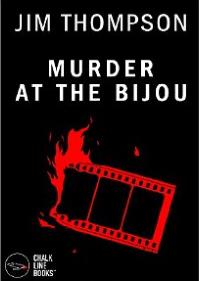|
So Thompson has chops
and it's no surprise that there's been a revival of interest in his work... or
shall we say, an emancipation from the crime fiction ghetto. The crime in Bijou
has some resemblance to the scam in James M. Cain's
Double
Indemnity, although Cain is a romantic compared to Thompson.
Here's the set-up:
having eliminated the competition, Joe Wilmot runs the best and only movie
house in Stoneville, The Barclay, which he owns with his older wife, the former
Elizabeth Barclay, the daughter of a once important local family. Joe has
worked his way up from being a film delivery boy, doing runs from a nearby
unnamed city to the various small town theatres in the surrounding counties.
Crime is in his background -- he came from an orphanage, did some time in a
reform school for vagrancy -- so his world-view is cynical and his low-level
criminal pragmaticism just part of a businessman's modus operandi where every
other businessman on Main Street is trying to screw him.
"You've got the most
remarkable record for chiseling I've ever laid eyes on," says Sol Panzer, the
predatory chain-theatre owner and business rival. Joe is laid up in bed
suffering from nervous exhaustion (mistaken for grief) when Sol visits him...
and of course it's a case of the kettle calling the pot black as just about
everyone in this story is a needler and a chiseler.
Elizabeth recruits a
young farmer's daughter, Carol, as a domestic helper, although it's obvious the
childless Wilmots have no need of a domestic, and while she's no beauty,
Carol's feral eroticism soon has her in the sack with Joe. Elizabeth catches
them out, yet it seems she hired Carol for just this purpose. Joe needs sex,
she needs money; in fact, they both need money because a cash crunch is
looming, and the sharks are circling. Everyone is putting the squeeze on Joe:
his employees, the movie projectionists' union, the distributors, a large movie
theatre chain, his fellow businessmen in Stoneville... even his damn wife, who
wants to be gone, and will be gone if she can get her hands on the 25 thou, her
part of the "double indemnity" insurance policy the couple hold on each other.
And while murder is
part of the plan, all three in this unholy menage à trois are
collaborators, albeit uneasy ones. Harness this with the fact that a couple of
people want to get their hands on the Bijou, and two or three more want revenge
on Joe for past grievances, and that all of the spectators to the "tragedy"
seem to be psychic (perhaps arson does that), the subsequent action is both
heavy on the paranoia and the double dealing.
As a tap on the movie
theatre business, the novel has a textbook accuracy, an insider's
been-there-done-that view, so Joe Wilmot's fatal career reads like part of an
autobiography. The sociology is classic noir, complete with casebook
forensics and a protagonist with the expertise to pull off the crime. Perhaps
Elizabeth as a passive-aggressive femme fatale is a bit shadowy,
especially later in the action, and the sexual dynamic of the menage
à trois anti-erotic... although this adds realism, because, while
certain couples often defy logic, trios always make sense.
"The next thing I
knew, I was back as far as my memory went..."
In noir, there
are always at least two victims, the corpse and the patsy. There can be more,
and here... well, the reader will have to find out. This is a tricky narrative,
full of switcharama sub-plots and flashbacks, although the forward linearity is
relentless. Joe's vernacular monologue is full of street savvy and casual
fatalism. The dialogue moves the action and monologue stories are used as
sideways illustrations (or parables). Symbolism? Yes, we get symbolism.
Thompson even inserts himself for a brief, ironic cameo (p.78), the sort of
post-modern conceit we've seen filmmakers from Hitchcock to Fellini use.
Of course most people
will miss this, the virtuosity masked by its own easy movement. Writers will
marvel, aficionados sweat. If it wasn't for the brutality of it all, the
venality and the desperate corruption, some might call the writing beautiful.
Thompson isn't for everyone. He's masculine, like a poker game is masculine,
with lots of psychic foreplay, bluffing, innuendo, and dangerous gambling.
Lying, cheating, false conviviality... all this is routine, love and honor just
words.
The ugly face of
capitalism? No wonder Thompson joined the Communist Party briefly in the hungry
thirties. Still, he could and did write lighter stuff, two of which were made
into movies -- The Getaway (1972 & 1994) and The Grifters (1994). Even the
Steve McQueen-Ali McGraw version of The Getaway is almost a chick flick, is
more style than substance despite being directed by the master of Hobbesian
violence, Sam Peckinpah.
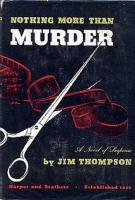
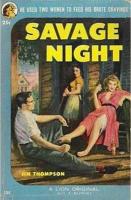
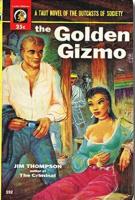
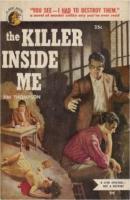
This is a nice reprint
edition by the DeVault-Graves Agency under their Chalk Line Books imprint,
which seems to be modelled on the Black Series crime paperbacks started by the
French publishing house Gallimard in 1945. The black pen line drawings by
Martha Kelly add an extra element of cool.
Bijou was first
published in 1949 as Nothing More Than Murder. It might be the best of
Thompson's work, although of course we haven't read it all. It's just possible
that Murder At the Bijou rates as the definitive marker of the move by the
American novel from document to schematic, book to scenario.
© LR
January 22 2016
Available directly
from
the
DeVault-Graves Agency»»
Jim Thompson:
Murder At The Bijou from Amazon:
US
|
Canada
|
UK
|
Australia
*Check out LR's
novel
RADIO
BRAZIL »»
««
CC
Books
|
